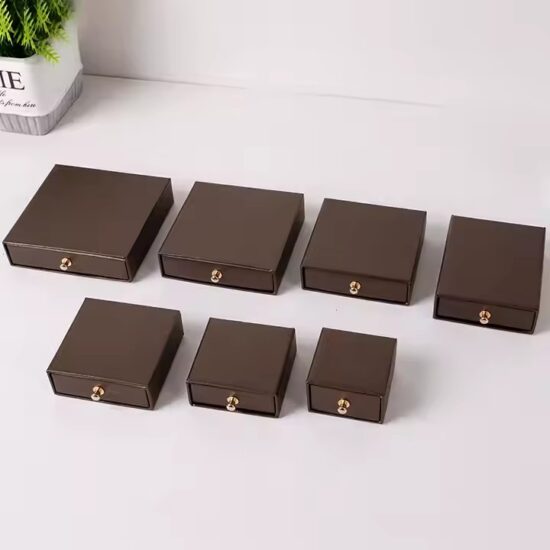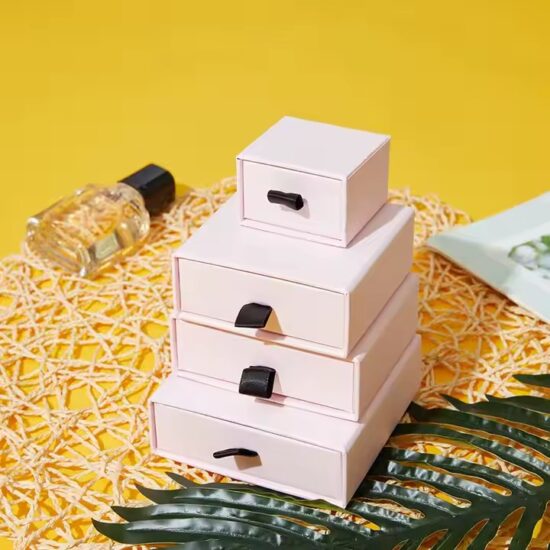jay@nbdho.com
Understanding the Structural Design of Paper Jewelry Boxes for Custom Packaging
Understanding the Structural Design of Paper Jewelry Boxes
In the world of jewelry packaging, structure matters just as much as style. A well-designed paper jewelry box not only protects the contents but also enhances brand value and elevates the unboxing experience. Whether you’re sourcing for retail, gifting, or luxury branding, understanding the structural components of paper jewelry boxes is essential.
Here’s a breakdown of the key structural design elements that define paper jewelry boxes:
1. Lid Styles: How the Box Opens Matters
The lid design greatly affects usability, branding, and the perceived value of the box. Common lid structures include:
-
Lift-off Lid (Top & Bottom Box)
A classic two-piece box with a separate lid that lifts off. Ideal for rings, earrings, and small gifts.
Pros: Simple, clean lines; easy branding on both parts. -
Magnetic Flip Lid
Includes a flap with embedded magnets for a secure and elegant closure.
Pros: Sleek and modern; adds a luxury feel. -
Drawer-Style (Sliding Box)
One part slides out from an outer sleeve, like a drawer.
Pros: Unique presentation; often used for branded sets or special editions. -
Book-Style Box (Flip-Open)
Opens like a hardcover book, with a spine and internal tray.
Pros: Great for storytelling and insert cards.
2. Inserts: Holding Jewelry Securely in Place
Inserts are essential for both presentation and protection. They’re typically made from EVA foam, cardboard, or velvet-covered sponge and are die-cut to fit specific items.
-
Ring Holders
Slotted or cushioned to securely hold one or multiple rings. -
Earring Cards or Foam Inserts
Pre-punched or notched for studs, dangles, or hoops. -
Necklace Boards
Often with hooks or soft clips to hold chains without tangling. -
Universal Sponge Pad
Used in lower-cost boxes, covered with fabric or paper.
Custom inserts can also be tailored with branding, materials, and color to match your product style.
3. Closure Types: From Functional to Fancy
Different closures affect both security and style. Common closures include:
-
Magnetic Flap
For a premium feel and secure closing mechanism. -
Ribbon Tie
Adds a soft, feminine look—often used for bridal or romantic gifts. -
Tuck-In Flap
A paper flap inserted into the box, often used in foldable or eco styles. -
Elastic Band or Sleeve Wraps
Practical for keeping the box shut during transport.
4. Material Structure: Thickness & Rigidity
Most paper jewelry boxes are constructed with:
-
Rigid Greyboard (900gsm–1500gsm): Provides structural strength
-
Duplex Board or Kraft Board (for folding types): Lightweight and cost-efficient
-
Laminated or Coated Paper: Adds surface durability and visual texture
The thickness and layering directly influence box stiffness, durability, and load-bearing capacity.
5. Surface Finishes That Highlight Structure
Structural design is complemented by surface treatments such as:
-
Embossing/Debossing: Emphasizes logo or pattern along the surface structure
-
Foil Stamping (Gold/Silver): Applied on flat lids or flaps for elegance
-
Spot UV or Matte Lamination: Enhances texture contrast
Surface design often follows and enhances the physical structure of the box.
6. Special Features: Windows, Layers & Compartments
To enhance user experience or meet functional needs, structural add-ons may include:
-
Clear PVC Window: Allows customers to preview jewelry without opening
-
Layered Compartments: Great for sets or multi-item storage
-
Hidden Compartments or Fold-Out Trays: For surprise or luxury effects
📦 Conclusion
Understanding the structural design of paper jewelry boxes is key to choosing packaging that reflects your brand identity, protects your product, and impresses your customer. From lid style to internal layout, every element can be customized to enhance function and visual appeal.
Whether you’re designing packaging for a minimalist, eco-friendly brand or a high-end jewelry line, structural design is where practicality meets branding. Need help designing your own custom paper box? Contact us for structural samples and design support.





